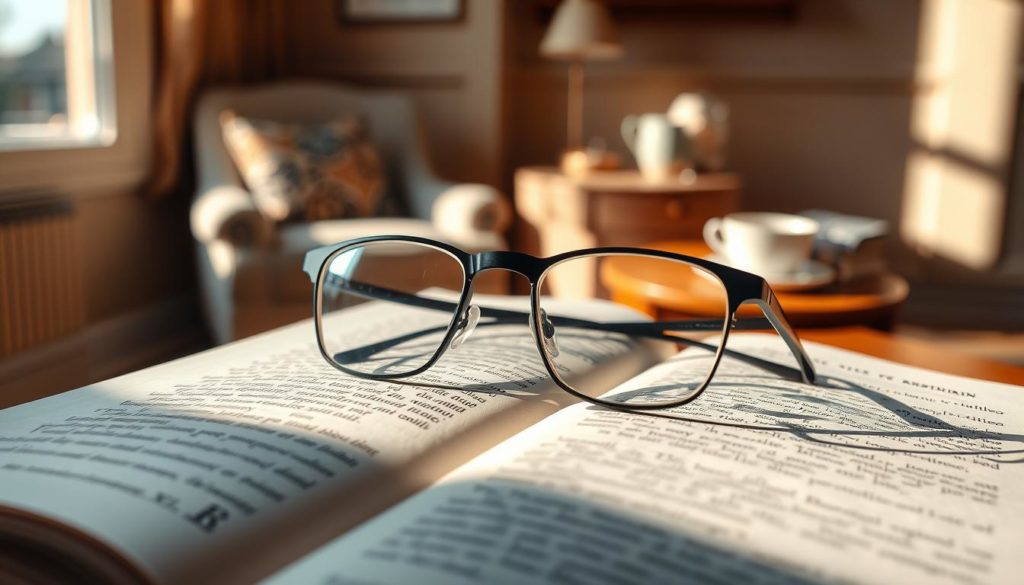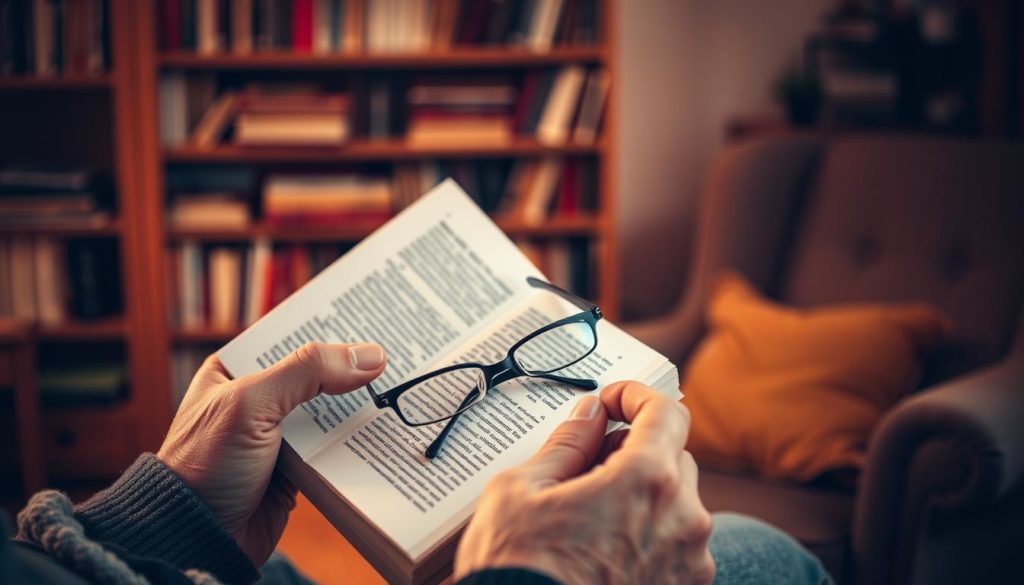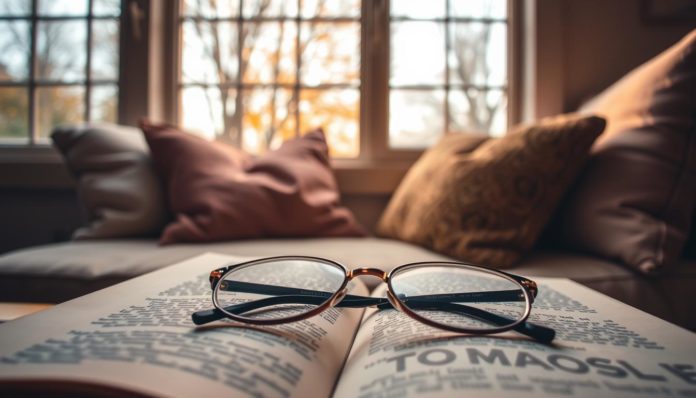Did you know over 83% of Americans experience presbyopia by 45? This is a gradual loss of focus on nearby objects. Knowing when to start using reading glasses can greatly improve your daily life. This guide will help you understand when it’s time to use reading glasses for better vision.
Are you squinting at small text or holding your phone too far away? It might be time for reading glasses. These signs often sneak up on us until they affect our daily lives. Spotting these signs early can keep your vision comfortable and clear.
Switching to reading glasses doesn’t have to be hard. By paying attention to your vision changes and recognizing the signs, you can make a smooth transition. Ready to learn more about when to use reading glasses and the signs to look out for? Let’s start!
Understanding the Need for Reading Glasses
Keeping your eyes healthy means knowing when you need reading glasses. As we get older, our eyesight can get worse. This reading glasses guide offers valuable reading glasses information. It helps you understand the importance of clear vision and spotting early signs of vision loss.

The Importance of Visual Comfort
Good vision is key for everyday tasks, like reading or checking emails. It’s important to avoid eye strain when looking at close objects. A reading glasses guide can help you find the perfect pair. This makes reading and other tasks more comfortable and clear.
Common Signs of Declining Vision
It’s crucial to know when your vision is getting worse. Signs include squinting, trouble focusing on close things, and needing to hold things further away. Spotting these signs early lets you get the right reading glasses information quickly. Don’t ignore these signs; the right glasses can greatly improve your eye health.
Key Signs You Need Reading Glasses
Knowing when you need reading glasses can make reading more comfortable. Let’s look at the signs that tell you it’s time to get some.
Difficulty Reading Small Print
Struggling with small text is a big sign. It could be in books, menus, or phone screens. This happens because our eyes get weaker over time. If you squint or ask others to read for you, it’s time to think about reading glasses.

Frequent Eye Strain and Fatigue
Eye strain and fatigue can sneak up on you, especially if you read or work a lot. Symptoms include headaches, dry or watery eyes, and discomfort. Getting reading glasses early can help with these problems and give you quick relief.
Holding Reading Material Further Away
Holding things further away to see them clearly is another sign. This is your body’s way of trying to help your eyes. If you find yourself doing this a lot, it’s time to think about getting reading glasses to make reading easier.
| Key Sign | Description |
|---|---|
| Difficulty Reading Small Print | Struggling with tiny text on books, menus, and screens |
| Frequent Eye Strain and Fatigue | Experiencing headaches, dry or watery eyes during detailed tasks |
| Holding Reading Material Further Away | Adjusting the distance of reading materials to improve focus |
Age and Reading Glasses: What to Expect
As we age, our vision changes. It’s important to know when to use reading glasses. This helps us deal with these changes better.
Age-Related Vision Changes
Our vision often gets worse with age. This makes it hard to focus on things close up. It’s because our eye lenses lose flexibility.
Presbyopia and Its Onset
Presbyopia starts in the early to mid-40s. It makes it hard to focus on near objects. This is why many people need reading glasses. Knowing when to use reading glasses helps keep our vision clear for everyday tasks.
When to Use Reading Glasses: A Guide
Modern life often requires us to do things that strain our eyes. Knowing how to use reading glasses can improve your life a lot. Here’s a guide to help you use reading glasses the right way for clear vision.
- Reading Books and Newspapers: This is the most obvious use. Reading small print in books or newspapers gets much easier with reading glasses.
- Using Digital Devices: Whether it’s a phone, tablet, or computer, reading glasses tips suggest a dedicated pair for screen use can reduce eye strain.
- Crafting and Hobbies: Activities like knitting, painting, or building models often involve detailed work. Reading glasses can help a lot.
- Office Work: For those who read documents or spreadsheets a lot, using reading glasses can keep you productive and reduce eye fatigue.
- Cooking and Recipes: Reading small print on recipe books or ingredient labels can be hard. Reading glasses make meal prep more fun.
Knowing how to use reading glasses in these situations can greatly reduce eye strain and discomfort. By following these reading glasses tips, your visual experiences will be both comfortable and productive.
How to Choose the Right Reading Glasses
Finding the perfect pair of reading glasses can make a big difference. It can improve your reading experience and make your eyes feel better. Here are some key things to think about when choosing.
Lenses and Magnification
Choosing the right lens magnification is crucial for clear vision. A good reading glasses guide suggests starting with a low magnification. Then, adjust as needed based on your comfort.
Always check the product labels and talk to optical professionals. They can help you make the best choice.
Frame Styles and Material
The design and material of the frame should match your style and be comfy for long use. You can choose from plastic, metal, or acetate frames. Each has its own benefits.
For example, plastic frames are light, while metal frames are durable. Pick a style that looks good and feels right.
Getting a Professional Eye Exam
Getting a professional eye exam is essential. It ensures your reading glasses fit your needs perfectly. An optometrist can give you personalized advice and find the right magnification for you.
This step is crucial for the best results. It’s a key part of the reading glasses guide.
Best Practices for Using Reading Glasses
Using reading glasses right can make a big difference. By following some simple tips, you can enjoy better vision every day.
Start by wearing your glasses when you need to focus closely. This includes reading, writing, or using digital screens. It helps you see better and keeps your eyes from getting tired.
Also, using your glasses with other tools can help a lot. For example, if it’s hard to read in dim light, try using a reading lamp. A lamp with an adjustable arm can direct light right where you need it. This makes reading much easier and more comfortable.
Don’t forget to get your eyes checked regularly. Your vision can change, so it’s important to get your prescription updated. This is a key part of taking care of your reading glasses.
- Proper Usage: Use your reading glasses consistently for activities involving close focus.
- Combining Vision Aids: Pair your glasses with appropriate lighting or other optical aids.
- Regular Eye Exams: Schedule regular visits to an eye care professional to keep your prescription up-to-date.
Lastly, make using reading glasses a part of your daily routine. Always carry them with you and have a place to keep them at home and work. By following these tips, you’ll see a big improvement in how well you can read and see.
Common Questions About Reading Glasses
Many questions come up about reading glasses. This section answers some common ones to help you understand more.
Can Reading Glasses Improve Computer Vision?
Some people ask if reading glasses help with eye strain from computers. Reading glasses can make text clearer on screens. But, they’re not made for long computer use.
For that, computer glasses are better. They block blue light to lessen eye strain. Still, reading glasses can help with occasional screen reading.
When to Upgrade Your Reading Glasses
Knowing when to get new reading glasses is important. Here are signs you might need a new pair:
- Difficulty Seeing Text Clearly: Trouble reading what you used to see easily means it’s time for new glasses.
- Frequent Headaches: Headaches often mean your glasses don’t have the right strength anymore.
- Eye Strain: Eye strain after short reading times means your eyes are working too hard. It’s time for new lenses.
Watch for these signs to keep your vision sharp. Stay updated with our reading glasses FAQs. This way, you’ll always have the right information for your needs.
Tips for Adjusting to Your New Reading Glasses
Getting new reading glasses is both exciting and challenging. Here are some helpful tips to make the transition smoother:
Gradual Adaptation Techniques
When adjusting to reading glasses, it’s vital to take things slow. Start by wearing them for short periods each day:
- Buildup Wear Time: Gradually increase the duration you wear your glasses, starting with 30 minutes and adding more time each day.
- Alternate Usage: Use your new glasses alongside your old habits to allow your eyes time to adjust.
- Breaks: Ensure you take regular breaks to minimize eye strain during the adjustment period.
Maintaining and Caring for Your Glasses
Proper care is essential to ensure the longevity of your reading glasses:
- Cleaning: Use a microfiber cloth and lens cleaner to keep your lenses spotless.
- Storage: Always store your glasses in a protective case when not in use.
- Handling: Handle your glasses by the frame to avoid fingerprints and smudges on the lenses.
By following these practical reading glasses tips and utilizing adjusting to reading glasses strategies, you can enjoy clearer vision with your new eyewear in no time.
How to Measure the Effectiveness of Your Reading Glasses
It’s important to check if your reading glasses work well. Look for clear vision when doing close-up tasks. This includes reading, sewing, or using a computer. You should see a big difference in detail and sharpness.
If you’re squinting or having trouble with small print, it’s time to think about a new pair. Comfort is key when wearing glasses for a long time. They should feel good and not cause headaches, eye strain, or tired eyes.
Wearing your glasses more often or finding them less effective is a sign to update your prescription. Regular visits to your eye care professional can also help. They can make sure your glasses are working right for you.
FAQ
When should I start using reading glasses?
You might need reading glasses if you squint or hold things far away to see. Frequent headaches after reading or trouble with small print are also signs.
What are some common signs that I need reading glasses?
Trouble with small print, eye strain, and needing to hold texts far away are signs. These often mean your near vision is getting worse.
Why is visual comfort important?
Good vision comfort is key for daily life. Bad vision can cause headaches, fatigue, and trouble focusing. This makes reading or computer work harder.
How do age-related vision changes affect the need for reading glasses?
As you get older, especially after 40, your eyes have trouble focusing on close objects. This is called presbyopia. It often means you need reading glasses for clear close-up vision.
What scenarios require the use of reading glasses?
You’ll need reading glasses for reading, using your phone, working on a computer, or any close-up task. They help you see clearly and reduce eye strain.
How do I choose the right reading glasses?
First, figure out the lens magnification you need through an eye exam. Then, pick frames that fit your style and are comfy. Getting advice from an eye care professional is a good idea.
What are the best practices for using reading glasses?
Always use your reading glasses for close-up tasks. Store them right when not in use and clean them often. If you use other vision aids, know how to use them together.
Can reading glasses improve computer vision?
Yes, reading glasses can help with computer vision, especially for small text or detailed graphics. But, you might need a pair made for computer work.
When should I upgrade my reading glasses?
If your current glasses don’t work well anymore or cause eye strain and fatigue, it’s time for a new prescription.
How can I adjust to my new reading glasses?
Start by wearing your new glasses a little each day to get used to them. Wearing them regularly for reading and close-up tasks will help. Also, keep them clean to make them last longer.
How do I measure the effectiveness of my reading glasses?
Check if your vision is clear for close-up tasks. See if you’re comfortable for longer periods. If you don’t get headaches and your eyes don’t strain, your glasses are working.


